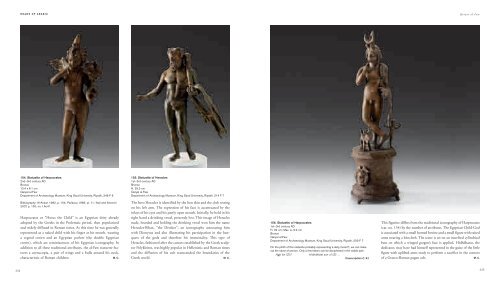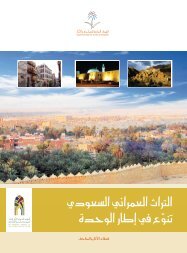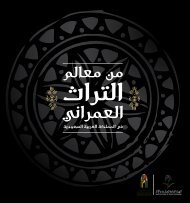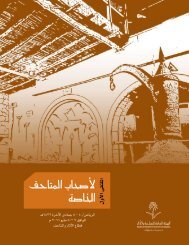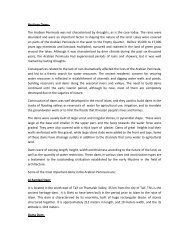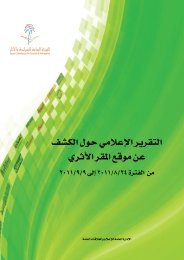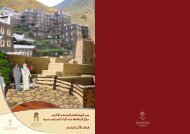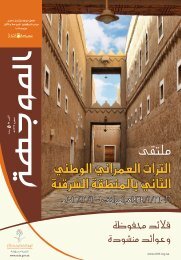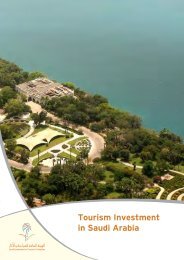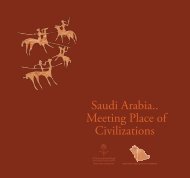Roads of Arabia
Roads of Arabia
Roads of Arabia
You also want an ePaper? Increase the reach of your titles
YUMPU automatically turns print PDFs into web optimized ePapers that Google loves.
18bis Arabie US p318-363.qxd 23/06/10 22:12 Page 334<br />
ROADS OF ARABIA<br />
Qaryat al-Faw<br />
154. Statuette <strong>of</strong> Harpocrates<br />
2nd–3rd century AD<br />
Bronze<br />
12.4 x 6.1 cm<br />
Qaryat al-Faw<br />
Department <strong>of</strong> Archaeology Museum, King Saud University, Riyadh, 248 F 6<br />
155. Statuette <strong>of</strong> Heracles<br />
1st–3rd century AD<br />
Bronze<br />
H. 25.3 cm<br />
Qaryat al-Faw<br />
Department <strong>of</strong> Archaeology Museum, King Saud University, Riyadh, 214 F 7<br />
Bibliography: Al-Ansari 1982, p. 104; Parlasca 1989, pl. 11; ‘Aqil and Antonini<br />
2007, p. 150, no. I Ac4/.<br />
Harpocrates or “Horus the Child” is an Egyptian deity already<br />
adopted by the Greeks in the Ptolemaic period, then popularized<br />
and widely diffused in Roman times. At this time he was generally<br />
represented as a naked child with his finger at his mouth, wearing<br />
a vegetal crown and an Egyptian pschent (the double Egyptian<br />
crown), which are reminiscences <strong>of</strong> his Egyptian iconography. In<br />
addition to all these traditional attributes, the al-Faw statuette features<br />
a cornucopia, a pair <strong>of</strong> wings and a bulla around his neck,<br />
characteristic <strong>of</strong> Roman children. M. C.<br />
The hero Heracles is identified by the lion skin and the club resting<br />
on his left arm. The expression <strong>of</strong> his face is accentuated by the<br />
inlays <strong>of</strong> his eyes and his partly open mouth. Initially, he held in his<br />
right hand a drinking vessel, presently lost. This image <strong>of</strong> Heracles<br />
nude, bearded and holding the drinking vessel won him the name<br />
Hercules-Bibax, “the Drinker”; an iconography associating him<br />
with Dionysus and also illustrating his participation in the banquets<br />
<strong>of</strong> the gods and therefore his immortality. This type <strong>of</strong><br />
Heracles, fashioned after the canons established by the Greek sculptor<br />
Polykleitos, was highly popular in Hellenistic and Roman times<br />
and the diffusion <strong>of</strong> his cult transcended the boundaries <strong>of</strong> the<br />
Greek world. M. C.<br />
156. Statuette <strong>of</strong> Harpocrates<br />
1st–3rd century AD<br />
H. 32 cm; Max. w. 9.2 cm<br />
Bronze<br />
Qaryat al-Faw<br />
Department <strong>of</strong> Archaeology Museum, King Saud University, Riyadh, 209 F 7<br />
On the plinth <strong>of</strong> this statuette probably representing a deity (lunar?), we can make<br />
out the name <strong>of</strong> person. Only a few letters can be deciphered in the visible part:<br />
Hdrt bn (Z)‘[<br />
Hidhdhārat son <strong>of</strong> (Z)‘…<br />
(transcription C. R.)<br />
This figurine differs from the traditional iconography <strong>of</strong> Harpocrates<br />
(cat. no. 154) by the number <strong>of</strong> attributes. The Egyptian Child-God<br />
is associated with a small horned bovine and a small figure with raised<br />
arms wearing a loincloth. The scene is set on an inscribed cylindrical<br />
base on which a winged gorgon’s face is applied. Hidhdharat, the<br />
dedicator, may have had himself represented in the guise <strong>of</strong> the little<br />
figure with uplifted arms ready to perform a sacrifice in the context<br />
<strong>of</strong> a Graeco-Roman pagan cult. M. C.<br />
334<br />
335


